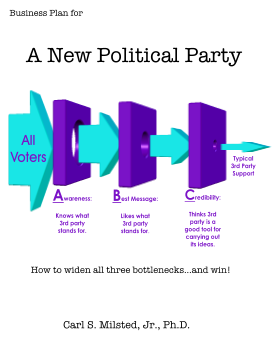The Original Anti Terrorism Act
Terrorism is nothing new. In fact, it was a far bigger problem in the early days of our republic – and before. Only the names have changed. Those whom we call terrorists today went under other names: pirates, bandits, gangs, Indians on the warpath.
Such terrorist attacks were more frequent, and sometimes more devastating than all the accomplishments of al Qaeda. Yet we didn’t establish a Department of Homeland Security until the 21st Century. The very idea of such a department was limited to dystopian fantasies up until not long ago.
This is not to say that our ancestors ignored terrorist threats. Far from it. But they also feared an overly large security apparatus. Even standing armies were viewed with suspicion. Unlike most moderns, the Founding Fathers were well versed in the history of Rome and other failed republics. As a nation does war, so a nation governs. And so the Founders quickly amended the Constitution to include a guarantee of defense by The People:
A well regulated militia being necessary to the security of a free state, the right of the people to keep and bear arms shall not be infringed.
Notice the wording. The Second Amendment is not about the right to go deer hunting. Nor is it about the right to armed revolution; the Constitution authorizes the federal government to suppress insurrections. The Second Amendment is about ensuring that the government remains a government of The People so we never need to have that armed revolution to restore the republic in the first place. Civil libertarians take note: The Second Amendment is to national defense what Open Source is to software.
Professional militaries mean professional government. When Rome professionalized its army, the old republic gave way to empire. The Founders read this important bit of history and so wanted a military consisting of people who had day jobs outside of government. For most, military service was to be constrained to times of actual war.
Some of ye reading this may find the idea quaint. In these days of satellites, super weapons and tightly integrated military systems, a hasty formation of men with their personal weapons is no match for a modern great power. True, an armed society would be more expensive to subdue than the gun-controlled nations conquered by Hitler last century, but the armed citizens would be rather quickly reduced to bands of guerillas – and terrorists. And so our traditional militia system has given way to the National Guard, where part-time soldiers use government owned and controlled weapons and fight alongside the professionals when called.
Then again, this was also the case in Washington’s day. To fight off a great power (Britain), Washington drilled his volunteers into a true regular army.
Fighting off great powers was not the only duty of the citizen militias described in the Constitution. From the early Colonial era, the European settlers had to deal with pirates, slave revolts, and Indian raids, situations quite analogous to modern terrorism. (Troubled by that last sentence? Good. Keep reading.) Having enough professional protectors on call to protect all the soft targets would have required a police state from the start.
After the Civil War, terrorists included the Ku Klux Klan and the large criminal gangs of the Wild West. Debate on the 14th Amendment included discussion on the importance of arming the freed slaves for self preservation (versus simply relying on state protection). Ye need but watch old Westerns to see the militia ethos carried out against the criminal gangs. Civilians rode shotgun on stage coaches. Passengers carried arms on trains and sometimes aided in the defense against train robbers. Sheriffs and federal marshals deputized a posse of civilians to deal with criminal gangs.
Somehow we forgot our history when 9/11 hit. Terrorists took over planes armed merely with box cutters.
The Real Lesson of 9/11
Here is the real lesson of 9/11: our excessive reliance on dialing 911 is dangerous. On that fateful day our professional protectors did their jobs. They acted heroically in many instances. And they failed. The only people to have even partial success at thwarting the terrorists were Todd Beamer and other passengers on United Flight 93. And even they only had partial success. They prevented the plane from hitting yet another target, but failed to save themselves or the other passengers. Had they acted more quickly, they might well have overwhelmed the hijackers early in their attack. The terrorists were poorly armed and greatly outnumbered. But acting quickly ran against our government’s 911 conditioning.
What should have been our domestic response to 9/11? How about arming the pilots? Most of them are ex military. Maybe even arm the stewardesses too. It need not be guns. Perhaps Tasers with an electronic locks keyed to hard-to-remove jewelry could be issued. And most importantly, the American people needed to be deconditioned from their serf mentality. Our President should have publicly asked the television stations to run a marathon of old Westerns to remind us of our heroic past. And maybe the FAA could have added a little something to the preflight safety message:
In the event of a terrorist attack you will find a dagger located in the seatback in front of you. Remove dagger and insert it into the nearest terrorist shouting an appropriate battle cry…
We had a supposedly conservative president. He was from Texas. He knew our past and rejected it in favor of creating a police state. Even FDR was better at enlisting civilian participation in the defense of this country. For this and other bungles, George W. Bush goes down in my book as possibly the worst president since Wilson.
And Now, for a Bit of Political Correctness
All this talk of cowboys and Indians is probably a bit disturbing to a young generation brought up on Dances with Wolves and Avatar. American Indians as terrorists?? Weren’t the palefaces in the wrong most of the time? And I even threw in suppressing slave revolts as an early reason for having a militia. Boo!
This is all true. But how is this any different from the plight of the Palestinians? Or the Roman Catholics in Northern Ireland? Or the Basques? Overpowered persecuted minority groups often resort to terror tactics because that is the only option they have left. Of course, once they do so, it is hard to sympathize with them. Rage after attacks on civilians is perfectly reasonable. Rewarding terror attacks is a bad idea.
Back to the early “terrorists.” The natives of this land often fought pitched battles against the better armed European settlers. They weren’t called braves for nothing. But some tribes also indulged in bloody raids against civilian settlements. And even in pitched war, they fought by different rules. They openly tortured prisoners; anyone cowardly enough to be captured deserved such treatment in their ethos. This enraged the Europeans who came from a tradition of ransoming hostages. Rage inspired the whites to commit atrocities in return. The cycle of violence continued until one side was thoroughly crushed.
True, not all the violence on the parts of the whites was retaliatory. Naked greed and racism played a part as well. The expulsion of the Cherokees from northern Georgia was a particularly loathsome incident; the Cherokees had made peace and adopted a civilized mode of living and were still exiled westward.
But before ye neener-dance on the graves of our forbearers and wallow in political correctness, ask how much better are we today? Google around for estimates of how many civilians have been killed as a result of our conquests of Iraq and Afghanistan. I suspect the kill ratios are similar to the old days; the big difference is that the natives of this land were also devastated by disease on top of the wars. We can now sit back and enjoy movies like Dances with Wolves and Avatar today because it has been generations since the last Native American attack on a white settlement.
To deal justly and mercifully with persecuted peoples whose representatives resort to terrorism today, we likewise need a goodly gap between successful attacks. This begins with soft target defense, and the original spirit of the Second Amendment. The Second Amendment can be a tool for bleeding-heart politically correct liberals. The Second Amendment allows us to defend our soft targets without scrapping the rest of the Bill of Rights. And if we successfully defend our soft targets long enough, we can think objectively about our enemies and have a shot at sustainable political solutions.
Granted, a liberal approach to the Second Amendment would likely be to emphasize the “well regulated” part of “well regulated militia.” After all, many liberals supported a draft; it was Richard Nixon who gave us an all volunteer army. So be it. I oppose a draft, but could go something in between mandatory national service and the overly professional protection service we have today. How about military science, marksmanship and gun safety classes in our high schools? Maybe we could re-task those impossible-to-close military bases to be voluntary summer boot camps where law abiding citizens can get a taste for military life without an open ended commitment. And maybe concealed carry permits should be limited to revolvers. (And maybe police on the beat should be limited to revolvers as well…)
Not all terrorists represent persecuted people, of course. Osama bin Laden was hardly persecuted. He and his Taliban friends were terrorists in the tradition of the Ku Klux Klan. The Afghans in general aren’t nearly as sympathetic as the Native Americans, even if they never host terrorists again. They could use a generation of governance under Janet Reno or some other iron-fisted liberal until they learn to stop buggaring boys and mistreating women. (But since that is not going to happen, we’ll look at gentler means of civilizing these people in a future chapter.)
But even dealing with unmitigated bad-guy terrorists it is good to keep our rage under control so the innocent don’t get caught in the crossfire. And that means good soft target defense – and not just in the United States.
We have a neighbor to the south with a giant porous border that is threatening to become a failed state due to domestic terrorism: Mexico. The drug gangs there have enough money to pay the police more than the government does. But could they bribe the people as a whole? Suppose Mexico adopted a system of well paid elected peace officers supplemented with civilian posses as need be? Suppose all law abiding Mexicans were issued guns and lessons in their use. How long would the gangs persist?
And, of course, there is another option for taking down such criminal terrorists. We will address it in the next chapter.


